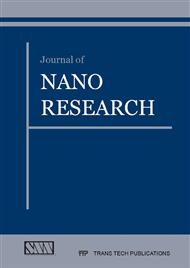[1]
C. Kethirabalan, A. Gurusany, Antibacterial activity of pH dependent biosynthesized silver nanoparticles against clinical pathogen. Biomedical Research International, (2014), Article ID 725165.
DOI: 10.1155/2014/725165
Google Scholar
[2]
E.C. Njagi, H. Huang, L. Stafford , H. Genuino , H. M. Galindo , J. B. Collins, G. E. Hoag G, S. L. Suib, Biosynthesis of iron and silver nanoparticles at room temperature using aqueous Sorghum Bran extracts. Langmuir 27 (2011) 264–271.
DOI: 10.1021/la103190n
Google Scholar
[3]
S. M. Ponder, J. G. Darab, J. Bucher, D. Caulder, I. Craig, L. Davis, N. Edelstein, W. Lukens, H. Nitsche, L. Rao, D. K. Shuh, T. E. Mallouk, Surface chemistry and electrochemistry of supported zerovalent iron nanoparticles in the remediation of aqueous metal contaminants. Chem. Mater 13. (2001).
DOI: 10.1021/cm000288r
Google Scholar
[4]
R. Yavukkumar, V. Elango, V. Rajendran, N. Kannan, Preparation and characterization of zero valent iron nanoparticles, Digest journal of nanomaterials and biostructures, 6 (2011) (4): 1771-1776.
Google Scholar
[5]
L. Li, M. Fan , R.C. Brown, J. V. Leeuwen, J. Wang, W. Wang, Y. Song, P. Zhang, Synthesis, properties and environmental applications of nanoscale iron based materials: A review. Critical Reviews in Environmental science and technology 36 (2006).
DOI: 10.1080/10643380600620387
Google Scholar
[6]
G.K. Pashetti, A. A. Telke, D. C Kalyani, S. P. Govindwar, Decoloration and detoxification of sulfonated azo dye methyl orange by Kocuria rosea MTCC 1532. J. Hazard. Mater. 176 (2010) 503–509.
DOI: 10.1016/j.jhazmat.2009.11.058
Google Scholar
[7]
Y-P Sun, X-Q Li, J. Cao, W-X Zhang, H. P. Wang, Characterization of Zero-valnet iron nanoparticles. Advances in colloid and Interface science, 120 (2006) 47-56.
DOI: 10.1016/j.cis.2006.03.001
Google Scholar
[8]
T. B Scott, I.C. Popescu, R.A. Crane, C. Noubactep, Nanoscale metallic iron for the treatment of solutions containing multiple inorganic contaminants. Journal of Hazardous Materials 186(2011) (1) 280-287.
DOI: 10.1016/j.jhazmat.2010.10.113
Google Scholar
[9]
D. J. Ingle, S.R. Crouch, Spectrochemical Analysis, 1st Ed, Prentice Hall, New Jersey(1988).
Google Scholar
[10]
L. Guo , Q. Huang, X-Y Li X, S. Yang , Iron nanoparticles: synthesis and application in surface enhanced Raman Scattering and electrocatalysis. Chem. Phy. 3(2001) : 1661-1665.
DOI: 10.1039/b009951l
Google Scholar
[11]
D. W. Elliott and W-X Zhang, Field assessment on nanoscale bimetallic particles for groundwater treatment. Environmental Sci. Technology 15 (2001) 4922-4926.
DOI: 10.1021/es0108584
Google Scholar
[12]
G-J Du, Z. Zhang, X-D Wen, C. Yu, Tr. Calway, C-S Yuan, C-Z Wang, Epigallocatechin gallate (EGCG) is the most effective cancer chemopreventive polyphenol in green tea. Nutrients, 4 (2012) 1679-1691.
DOI: 10.3390/nu4111679
Google Scholar
[13]
E. Palacios., P. Leret , J. F. FernáA, H. De Aza, M. A. Rodríguez, Synthesis of amorphous iron phosphate nanoparticles. Journal of nanoparticle research 14 (2012) 1131): 1-7.
DOI: 10.1007/s11051-012-1131-y
Google Scholar
[14]
G. Hoag, J. Collins, J. Holcomb, J. Hoag, M .R. Nadagouda Varma, Degradation of bromothylmol blue by greener, nano-scale zero-valent iron synthesized using tea polyphenols. J. Mater. Chem. 19 (2009) 8671–8677.
DOI: 10.1039/b909148c
Google Scholar


